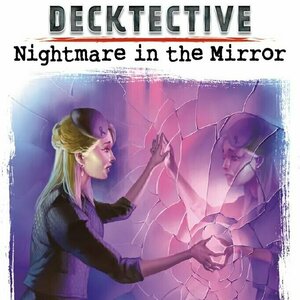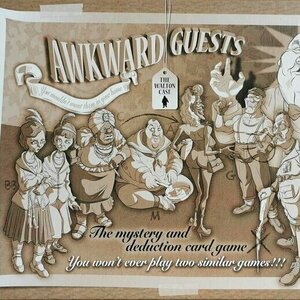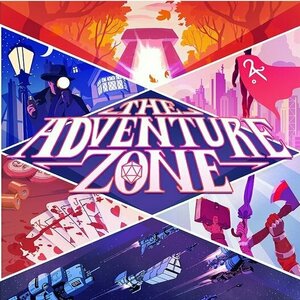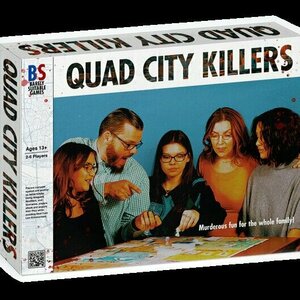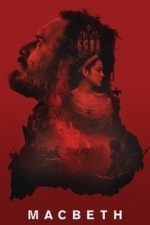
iBoost: Turbo Your Car!
Entertainment and Games
App
iBoost makes your car sound like it has a turbo! Featuring authentic sounds recorded from over 16...

The Boatman's Call by Nick Cave & The Bad Seeds
Album
For their 10th album – and follow-up to the cheery Murder Ballads – Nick Cave & The Bad Seeds...
Purple Phoenix Games (2266 KP) rated Decktective: Nightmare in the Mirror in Tabletop Games
May 29, 2021
Decktective: Nightmare in the Mirror (which I will just refer to as Decktective from here) is an immersive storytelling card game where the player(s) attempt to solve the case by the time the final cards are drawn from the deck. At the end of the game player(s) are asked questions and, depending on the answers given, are scored by how many questions were answered correctly.
DISCLAIMER: We were provided a copy of this game for the purposes of this review. This is a retail copy of the game, so what you see in these photos is exactly what would be received in your box. I do not intend to cover every single rule included in the rulebook, but will describe the overall game flow and major rule set so that our readers may get a sense of how the game plays. For more in depth rules, you may purchase a copy online or from your FLGS. -T
Setup is super easy. Open the box, place the paper clips nearby, and set out the deck of cards. The game comes with no rulebook; the cards instruct players what to do along the way. I will not be covering ever facet of the game to avoid potential spoilers, so please keep that in mind.
The mechanics of this game system rely on players either playing or discarding cards as they are drawn. Essentially, players will need to discard enough cards to be able to play others. For example, some cards hold a value of 1-10, meaning that they may only be played to the table once there is at least 1-10 cards already existing in the discard pile. So a card with a value of 4 requires at least four cards in the discard in order to play. So choices will need to be made to determine which cards are vital and which can be sent to the discard. The solo player is eventually told that they may have five cards in their hands and the deck will guide the player through the rest of the game.
I really don’t think I can go much further without spoiling something, so I will stop here and hope I have given enough description of the mechanics to help with understanding.
Components. This is a big deck of oversized cards and a few red plastic paper clips. The clips are fine, but are a little tight on the cards, so I did not leave them on very long. They are only used at the end to answer questions, so I was able to only briefly use them. The cards are big and nice quality and feature great art. I do not want to give away too much, but there are times where the cards and the box have interplay, and I think their usage is absolutely genius. Great job on that!
This is a tough one to give my thoughts on without spoiling some things, so I will be vague. Not because I want to be vague, but because I feel I need to be vague. As I played through the game (and this is one of those that may only be played ONCE ever) I found my head needed scratched and my brows needed furrowed. I usually am not a player that thinks through their turns for a long time, but I felt I gave each card fair consideration throughout. This paid off at the end, but I still finished with a score of 7 / 10. I felt I probably could have achieved the full 10 but I did not really think about my answer on a card, and that one was worth those 3 points.
So here is what I ultimately think about this one (and possibly the entire Decktective series, though I have not played any others): I love it. I have also played several games in the Deckscape series and I definitely prefer Decktective. Is is the system or the individual game though? I am unsure. What I can tell you for certain is that of the three titles in the Deck- family, this is by far my favorite. I really wish I could qualify it much more, but I will offer this: once you play through this title, please message me and I will chat with you about my actual opinions on the game with spoilers a-plenty.
I do recommend this one, as I had an absolute blast playing it, and I think that a good number of players from all ages and skill levels will also enjoy it. If you happen to share my general game preferences, then you will like this one a LOT. Another great benefit? Once you are done playing you can gift it to another gamer or family or library or whatever you like. That said, I am eager to try the other Decktective titles just as soon as I can!
Purple Phoenix Games (2266 KP) rated Awkward Guests in Tabletop Games
Aug 6, 2020
Mr. Walton has been murdered! You have been called in to investigate and get to the bottom of this gruesome mystery. By interrogating the suspects and the household staff, searching for clues, and examining the crime scene, you must decide WHO the killer is, WHY did they commit the murder, and HOW it was done. There may or may not even be an accomplice that needs to be caught too. Put your deduction skills to the test as you work to be the first investigator to solve the case!
Disclaimer: I do not intend to rehash the entire rulebook in this review, but rather give a general overview of the rules and gameplay. To read the entire rulebook, check out the game at your FLGS or directly from the publisher! -L
Awkward Guests is a card game of hand management, trading, and deduction in which the players are trying to be the first player to solve the murder of Mr. Walton. The game is actually pretty simple to play. To start, each player receives a hand of 6 cards and a case tracking sheet. The cards will have one or more references (case information) on them, as well as a value of 1-3 points, depending on the reliability of the information presented on the card. On your turn, you will ask for information about two different references in which you are interested. The other players will then look through their cards, and offer some or all that pertain to the chosen references in trade to the active player. The active player may then choose a player with whom to trade, giving that player any number of cards, as long as their value equals or exceeds the value of the cards received in trade. Look at your new cards, make notes on your case tracking sheet, and play continues to the next player. After all players have inquired and traded cards, players have the opportunity to solve the mystery. You must know WHO, HOW, and WHY, and possibly the identity of the ACCOMPLICE depending on case difficulty, in order to solve the mystery. If nobody is ready to solve, everyone discards their hand down to 3, and draws new cards to a hand size of 6. A new round then begins, and play continues until one player successfully solves the mystery.
When you get down to it, Awkward Guests is easy to learn and play. It mostly consists of trading cards to learn information. That’s it. And that’s what makes it a great game, in my opinion. Although it feels more involved than regular Clue, the gameplay itself is very similar and that familiarity is reassuring. One thing that elevates Awkward Guests above Clue is the fact that it requires so much more strategy than original Clue. In Clue, when asking for information, you are asking 1 specific opponent for information, and they have to provide it if they have it. In Awkward Guests, you are able to ask all opponents for information, and they can offer as much or as little information as they want. It increases the amount of strategy required to play, and takes it from a simple grid movement memory game, to one that encourages deduction and compromise. Since players are trading cards, you never know who is holding what cards at any given time, and that makes it harder to pinpoint the information you may need. You can’t just memorize another player’s hand of cards, because on any given turn that hand has completely changed. Along those lines as well, you have to decide what information you are willing to trade, in hopes of receiving useful information in return. You don’t want to just trade back the same cards to the same players in an effort to stunt their investigation, because that could deter them from trading with you in the future. You have to decide when is the right time to trade, and what information you are willing to hand to your opponents, because you need to be receiving new information as well.
Another brilliant thing about Awkward Guests is the amount of replayability. Each case uses a different combination of cards, and with so many cards, that means that thousands of different game decks could be generated and played as individual cases. The game design and card system boasts a possible total of 3,600 case solutions, each reached through these different card deck combinations. No matter how many times you play, it is almost guaranteed that you will never play the same case twice. That being said, the biggest downside of Awkward Guests for me is the actual game setup and teardown. Each case deck requires certain cards, so that means to set up, you have to search through all 243 cards and pull out only those required for the selected case. And then after the game, you must sort them all back into their correct order. That just takes a bit of time, and makes it a game that can’t just be played on the fly.
One other downside for me when playing Awkward Guests are the player screens. Each player receives a screen to block their case tracking sheet from opponents. As you learn information, you write it on your sheet to help keep track of your notes and accusations throughout the game. The player screens are also reference sheets, providing much gameplay information to alleviate the need to reference the rulebook at every turn. The downside is that there is just SO MUCH information in the player screens. It is quite overwhelming, and honestly, makes the game seem more complicated and confusing than it really is. I appreciate the effort to provide that cheat-sheet, but it needs to be majorly edited and redacted to be truly useful.
Let’s talk components. The game comes with some high quality double-sided case tracking sheets, and nice sturdy cards and cardboard components. It’s pretty simple, but really gets the job done effectively. The artwork is pretty basic and the color scheme is mostly monochromatic. It may not be the most exciting game to look at, but the lack of colors makes it feel appropriately thematic.
Overall, Awkward Guests is a good step-up game from Clue. It requires strategy, deduction, and even though the game is ultimately competitive, selective cooperation is a key to success. As a huge fan of Clue as a child, I can definitely say that I am a fan of Awkward Guests as an adult. Originally printed in a different language, this game was brought to Kickstarter with an English version in 2018, and I am certainly thankful that the decision was made to reprint it in English! If you like deduction games with a twist, I would absolutely recommend giving this one a shot. Purple Phoenix Games gives Awkward Guests a mysterious 17 / 24.
kelsey (8 KP) rated The Adventure Zone in Podcasts
May 29, 2019
Balance has since ended, and now the podcast has moved on to other TTRPGs like Fate (TAZ: Commitment), Powered By the Apocalypse (TAZ: Dust), and Monster of the Week (TAZ: Amnesty). Commitment and Dust are two short-run "test-drives" run by Clint and Travis respectively, and I personally adored a departure from the 5e system to not only be introduced to different TTRPGs, but to hear the DM-ing (or now GM-ing) styles of the other McElroys. In Amnesty, Griffin once again takes the reigns to run the game, and at the posting of this review, Amnesty is being considered the "second season" for TAZ. For some, these diversions from the 5e system may not work, but I recommend listening. They're just as creative and fun as Balance was, though different. I recommend coming in with an open mind, as going from the way Balance was to now, the show is quite different, but the heart is still there and the stories are still stunning.
If those aren't your speed, though, the McElroys post bonus games (like Four Sherlock Holmes) that are meant to be silly one-shot arcs AND they host a number of live-shows that bring back the beloved Balance characters into hilarious one-shot adventures, so you're never short of a dose of Magnus, Taako, and Merle. Being honest, the live shows are some of the funniest things I've listened to. They're marvelously fun, and the added time pressure of the show adds to the comedy. They also really bring back the actual-play atmosphere that sometimes gets lost during edited episodes.
I cannot recommend TAZ enough. Being honest, it pretty much saved my life. It brought (and still brings) me so much joy, and it encouraged me to try out TTRPGs--seriously, I took up DMing because of TAZ, and now I run TTRPG games weekly.
Do yourself a favor, roll perception with advantage and give this one a listen.
Purple Phoenix Games (2266 KP) rated Dreams of Tomorrow in Tabletop Games
Sep 17, 2020
Dreams of Tomorrow is game of set collection that utilizes a shifting rondel (I had to look up the definition too) in which players are working to weave a series of dreams into a complete Dream Sequence. Set in the future, players take on the roles of Dream Engineers, who are tasked with creating Dream Sequences to be sent to the past in an effort to save the future. Can you weave the most powerful Dream Sequence to alter the path of your present life, or is the future doomed to fall?
DISCLAIMER: We were provided a copy of this game for the purposes of this review. This is a retail copy of the game, so what you see in these photos is exactly what would be received in your box. I do not intend to cover every single rule included in the rulebook, but will describe the overall game flow and major rule set so that our readers may get a sense of how the game plays. For more in depth rules, you may purchase a copy online or from your FLGS. -L
To setup the game, place the Collective Consciousness (the rondel) in numerical order within reach of all players. Reveal a number of Dream cards from the Dream deck, based on the number of players, and these cards will create the communal Dreamscape. Each player receives a player card, cubes, and meeple in their chosen color, and sets their resources to the starting numbers, as described in the rulebook. All players begin with their meeples in the first space of the rondel, and in clockwise order, will select and pay for a Dream from the Dreamscape to be placed in their Dream Catcher (waiting area). Once all players have selected a Dream, and adjusted their resources accordingly, the game is ready to begin.
Dreams of Tomorrow is played over a series of rounds in which players will take turns performing 2 actions: Move and Take Action. Movement happens sequentially around the rondel, and players may choose how many spaces to move. To move 1-3 spaces is free, but to move more than 3 spaces will cost a number of resources. When a player decides to end their movement, they will then take the action indicated on the space on which they landed. These actions include: Gaining resources, Catching a Dream, Weaving a Dream, or Activating a Dream Ability. Gaining resources is pretty self-explanatory, and there is one neat thing to note: even if it is not your active turn, most of the rondel spaces have a Shared Effect, which grants an off-turn action to all non-active players. Catching a Dream means that you pay the requisite resources and select a Dream from the Dreamscape. Any caught Dreams go into your Dream Catcher until you are able to perform the Weave a Dream action. When you Weave a Dream, you again pay the requisite resources displayed on the Dream card and move the Dream from your Dream Catcher into your Dream Sequence (play area). To Activate a Dream Ability, you select a Dream card in your tableau, and use the ability printed on it. It is important to note that once Dreams are woven into your Dream Sequence, they will overlap each other, and only one Dream Ability will ever be available for use, so create that sequence wisely! Play continues in turns until one player has woven a Dream Sequence of five Dreams total. The round ends once all players have taken the same number of turns, and then final points are counted. The player with the highest score is the winner!
So all-in-all, how is Dreams of Tomorrow as a whole? I actually was very surprised at how much I enjoyed this game. When reading through the rules, it seemed kind of complicated and I was a bit worried before my first play. Once you actually get playing, however, the game is pretty intuitive and simple to play. One thing I particularly enjoyed about this game is its iconography. With only three resources and four actions, there are only seven icons of which to keep track. It keeps the cards from being cluttered with text, and makes the costs/abilities clear to understand. The iconography of the Dream Abilities, however, can be a liiiittle more complicated, but the game does come with Reference Cards which explain what every single icon means!
Another neat thing I enjoyed about this gameplay is the addition of Shared Effects. Even if you are not the active player, you will always gain some resource on everyone else’s turn. That adds an extra element of strategy because you have to amass your own resources for Dreams, but you have to be careful not to be giving your opponents too much extra help for themselves! Probably my favorite part of Dreams of Tomorrow are the actual Dream Abilities themselves. Performing the regular turn actions are pretty straight-forward, but Dream Abilities are more special and allow you to do even more on your turn. For example, some Dream Abilities allow you to change directions, move extra spaces, or even alter the Collective Consciousness, re-arranging the cards in a way to benefit you and hopefully hinder your opponents. The Dream Abilities are literal game-changers, and they really keep all players on their toes.
Talking about components, this game is of a pretty good quality. The cards are nice and sturdy, the player boards are decent, and the meeples and cubes are your standard wooden tokens. I’ve said in reviews before, but I always appreciate when games include Reference Cards for players, and Dreams of Tomorrow certainly delivered on theirs. The cards are clear, concise, and helpful during play. The artwork of this game is very vibrantly colorful and just plain pretty to look at. I found myself getting distracted by admiring the artwork, or catching Dreams based on their artwork, instead of taking their point-values or resources requirements into consideration. Oops. That’s just my bad, but the artwork really helps make the game more immersive.
Overall, I would say that Dreams of Tomorrow is a great little game. Admittedly, the rulebook is kind of daunting and seems a little overly complicated at first, but once you get into an actual game, it flows very quickly and easily. After just one turn, I got exactly what was happening and had no further questions about the gameplay. It really went above and beyond my expectations, and is one that I definitely look forward to bringing out in future game nights. Purple Phoenix Games gives it a dreamy 10 / 12. Check this one out if you haven’t before, it may just be the game of your dreams. (Ha, get it?)
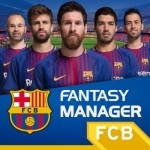
FC Barcelona Fantasy Manager 2017-Top soccer game
Games and Sports
App
The new edition of the free football live game from FC BARCELONA FANTASY MANAGER 2017 will bring the...
Purple Phoenix Games (2266 KP) rated Quad City Killers in Tabletop Games
Jan 30, 2021
Quad City Killers (or QCK) is a competitive game of moving around a map and eliminating points of interest by using resources from hand. Or, in actual gamespeak, stalking the streets of the QC murdering prey by using weapons, modifiers, and scenario cards to adjust the winds of chance for success.
DISCLAIMER: We were provided a prototype copy of this game for the purposes of this review. These are preview copy components, and I do not know for sure if the final components will be any different from these shown. Also, it is not my intention to detail every rule in the game, as there are just too many. You are invited to download the rulebook, back the game through the Kickstarter campaign ending March 5, 2021, or through any retailers stocking it after fulfillment. -T
To setup place the large map (an actual map that you would find in your grandparents’ Oldsmobile) on the table. Shuffle the Prey deck and the Resources deck separately and place them in their spots on the map. Place the Heat tokens on the lowest space in each city. Keep the three dice nearby for all players’ use. Each player will choose a serial killer profile mat, a color of skull mover token, and Dexterity token to track progress. Each player will also draw five Resource cards from the deck and one Prey card to place on the board in a city along with their skull mover token. The game may now begin!
The first thing each player will do on their turn is perform a Hunt action by drawing and placing on the map the top card of the Prey deck. Most Prey are color-coded to be placed in a matching city, but some are not and may be placed in any city on the map. Next, the player may perform any three actions from the following: Hunt, Travel, Attack, Scenario, Discard.
Hunt works the same as the action performed at the beginning of each turn: draw a Prey card and place it on the board. In order to Travel to a new city the player will roll the dice. For a value of 1+ the player may travel to any city within their current state. For a value of 2+ the player may cross the Old Man to the other side (preferably using the half-finished under-construction new I-74 bridge). A player may play a Scenario card from their hand, and if it shows the Action icon they will spend one of their three actions to play and resolve it. A player may also choose to Discard two cards from their hand and replace them with cards drawn from the Resource deck for an action.
The game would not be named Quad City Killers if killing was not involved somehow. As the final option of action to be taken on a turn a player may choose to Attack a Prey card in the same city in which the player’s token resides. To Attack, the player will consult the Prey card’s printed defense value for their target number. The player will then combine any Resource cards they may have in hand with their current Dexterity score (tracked on their player mat) and the roll of the three dice. If the end result matches or exceeds the Prey’s defense value the Prey is eliminated. The player collects the Prey card for a trophy and for its Notoriety value (victory points) at game end.
Resource cards come in different flavors: Weapons, Scenarios, Modifiers, and Ego. Weapon cards are just that: weapons. They may be used once for an attempted kill and then are discarded. Scenarios may mess with opponent tactics, allow players to move Prey cards to different cities, or other various activities. Modifiers may also adjust the current Advantage enjoyed by the player or be played on a Prey card to lower its defense value. Ego cards (and also some Weapon cards) will have an M.O. icon on them and may be placed directly on the player mat. These M.O. cards offer a once-per-turn advantage for the player and are very powerful.
The game continues in this fashion of taking turns moving around the map, hunting prey and killing them, and using Resources to adjust the difficulty of the murder. Once a player has increased their Dexterity token to the end of the track the game ends and the players count up Notoriety values (VP) of all slain Prey cards to arrive at the greatest serial killer the Quad Cities has ever seen (which, being from the QC would be saying something – I don’t remember ANY serial killers here).
Components. Okay, this was a super cool game to open up in the mail. Inside the mailer box was this strange Evidence bag. I have never seen an Evidence bag in my life so I wasn’t quite sure what was inside. But when I opened it and saw it was the components for the game I immediately smiled at how cool that was to include. It certainly made an impression. Now, please remember that this is a prototype copy of the game, and the finished version will have slightly different and improved components. That said, what we were provided is very close to final quality (and better than some games I have in my collection!). The cards are all fine, the dice are dice, and the tokens are well-designed and interesting. The best component, for me, is the excellent map of the QCA. It folds/unfolds like an old map would (prior to GPS) and has my hometown right on it! Luckily I live in a suburb(?) of the Metropolitan QCA so my house is nowhere to be found on the map, but it is very strange and exciting to play a game on a map of your home.
The game as a whole is pretty good. Though the estimated time to finish the game is quoted at 90-180 minutes (and maybe with the full compliment of players), my plays with my wife were well under an hour each time. We both enjoyed the game quite a bit once we got over the whole premise of it. The theme is obviously dark and macabre, but in the end it is still just a game.
I felt very engaged for every second of the game as I watched my wife nail roll after roll during her Attack actions while I fail to manage even a roll of 2+. Yes, I am unable to roll 2+ on THREE DICE. My issues aside, the dice really do add a layer of chance (obv) that all the accounting and cardplay just will not cover. I like that. I like chance in my games, even when it goes against me. I also enjoyed having five actions from which to choose three on my turn, but I could also use the same action all three times if I wished. More options is usually good, and having more than one obvious route or strategy is a huge bonus for me.
All in all I really did enjoy this game quite a bit. Again, the theme may be off-putting for some, and I will not play this game with my children until they are probably older than the suggested 13+ but I can definitely see myself breaking this out with a group of adults who are itching for something completely different from what they are accustomed to playing. If you are like me and need something just absolutely jarring in your collection, I urge you to take a look at Quad City Killers, on Kickstarter now until March 5, 2021. Just stay out of Milan (pronounced MY-lin) and we will be fine.
Gareth von Kallenbach (980 KP) rated Macbeth (2015) in Movies
Aug 6, 2019
Fassbender
as Macbeth and Marion Cotillard as Lady Macbeth.
There are a ton of blood and guts in this movie. Many of the action
scenes have slow-motion insets, which for me were better than the jerky
camera movement of the close-up fighting scenes, but still felt weird
inside the film.
This is the traditional Macbeth story-line, with the typical language of
the original play. The accents of most of the actors were very heavy,
making it quite difficult to follow the actual dialogue.
I was able to follow the story because I know the basic premise of
Hamlet (who doesn’t?) but if I hadn’t basically known what the story was
about, and had to rely solely on the spoken words in the film, I would
have been dreadfully lost.
Marion Cotillard plays a very good conniving, plotting Lady Macbeth, and
Michael Fassbender does a great job of portraying a manipulated, power
hungry man, being driven mad by his atrocities.
The supporting cast gave great performances as well. The three witches
were played by Lynn Kennedy, Seylan Baxter, and Seylan Mhairi Baxter.
They were sufficiently creepy and mysterious to add the right amount of
darkness to their roles, without overpowering the concept that had
Hamlet interpreted their predictions differently, the entire story may
have gone differently.
There were parts of the movie that I held my breath at, and felt myself
responding emotionally to, but it would be very hard NOT to feel some
sort of emotion at watching a family being burned at the stake at the
whim of a mad-man.
If I were a die-hard Macbeth or Shakespeare fan, I likely would have
enjoyed the film far more. On the other hand, a die-hard Shakespeare fan
probably would have been upset at some of the pieces that were trimmed
from the famous lines of the original (“something wicked this way comes”
was noticeably absent)
Overall I would give this movie 2 out of 5 stars, based on the hard time
I had understanding the dialogue. If I had been able to not have had to
concentrate so hard to understand what was being said, I would have
given it 3.5 out of 5 stars.

Sleep Timer & Nature Sounds
Health & Fitness and Lifestyle
App
Having trouble falling asleep? Insomnia? Snoring partner? NO PROBLEM! Play our carefully selected...
